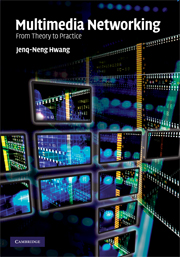Book contents
- Frontmatter
- Contents
- Preface
- Acknowledgements
- List of abbreviations
- 1 Introduction to multimedia networking
- 2 Digital speech coding
- 3 Digital audio coding
- 4 Digital image coding
- 5 Digital video coding
- 6 Digital multimedia broadcasting
- 7 Multimedia quality of service of IP networks
- 8 Quality of service issues in streaming architectures
- 9 Wireless broadband and quality of service
- 10 Multimedia over wireless broadband
- 11 Digital rights management of multimedia
- 12 Implementations of multimedia networking
- Index
1 - Introduction to multimedia networking
Published online by Cambridge University Press: 26 January 2010
- Frontmatter
- Contents
- Preface
- Acknowledgements
- List of abbreviations
- 1 Introduction to multimedia networking
- 2 Digital speech coding
- 3 Digital audio coding
- 4 Digital image coding
- 5 Digital video coding
- 6 Digital multimedia broadcasting
- 7 Multimedia quality of service of IP networks
- 8 Quality of service issues in streaming architectures
- 9 Wireless broadband and quality of service
- 10 Multimedia over wireless broadband
- 11 Digital rights management of multimedia
- 12 Implementations of multimedia networking
- Index
Summary
With the rapid paradigm shift from conventional circuit-switching telephone networks to the packet-switching, data-centric, and IP-based Internet, networked multimedia computer applications have created a tremendous impact on computing and network infrastructures. More specifically, most multimedia content providers, such as news, television, and the entertainment industry have started their own streaming infrastructures to deliver their content, either live or on-demand. Numerous multimedia networking applications have also matured in the past few years, ranging from distance learning to desktop video conferencing, instant messaging, workgroup collaboration, multimedia kiosks, entertainment, and imaging [1] [2].
Paradigm shift of digital media delivery
With the great advances of digital data compression (coding) technologies, traditional analog TV and radio broadcasting is gradually being replaced by digital broadcasting. With better resolution, better quality, and higher noise immunity, digital broadcasting can also potentially be integrated with interaction capabilities.
In the meantime, the use of IP-based Internet is growing rapidly [3], both in business and home usage. The quick deployment of last-mile broadband access, such as DSL/cable/T1 and even optical fiber (see Table 1.1), makes Internet usage even more popular [4]. One convincing example of such popularity is the global use of voice over IP (VoIP), which is replacing traditional public-switched telephone networks (PSTNs) (see Figure 1.1). Moreover, local area networks (LANs, IEEE 802.3 [5]) or wireless LANs (WLANs, also called Wi-Fi, 802.11 [6]), based on office or home networking, enable the connecting integration and content sharing of all office or home electronic appliances (e.g., computers, media centers, set-top boxes, personal digital assistants (PDAs), and smart phones).
- Type
- Chapter
- Information
- Multimedia NetworkingFrom Theory to Practice, pp. 1 - 10Publisher: Cambridge University PressPrint publication year: 2009
- 1
- Cited by



